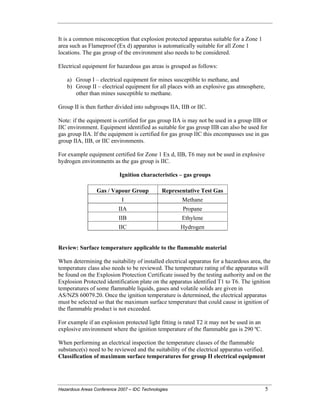Some Known Incorrect Statements About Roar Solutions
Some Known Incorrect Statements About Roar Solutions
Blog Article
Not known Details About Roar Solutions
Table of ContentsRumored Buzz on Roar SolutionsRoar Solutions for Beginners5 Simple Techniques For Roar Solutions
In order to shield installments from a prospective explosion a technique of evaluating and classifying a possibly dangerous location is needed. The objective of this is to make sure the appropriate option and setup of equipment to inevitably avoid a surge and to guarantee safety and security of life.
(https://pinshape.com/users/7197164-roarsolutions#prints-tab-open)
No tools needs to be installed where the surface temperature of the equipment is greater than the ignition temperature of the provided hazard. Below are some typical dust dangerous and their minimum ignition temperature. Coal Dust 380C 225C Polythene 420C (thaws) Methyl Cellulose 420C 320C Starch 460C 435C Flour 490C 340C Sugar 490C 460C Grain Dirt 510C 300C Phenolic Resin 530C > 450C Aluminium 590C > 450C PVC 700C > 450C Residue 810C 570C The possibility of the risk existing in a focus high sufficient to create an ignition will certainly differ from place to area.
Dangerous area electrical devices maybe designed for usage in greater ambient temperature levels. Area Repair Service By Authorised Employee: Challenging testing may not be needed however specific procedures might need to be adhered to in order for the equipment to maintain its 3rd event score. Each piece of equipment with an unsafe score ought to be assessed individually.
The 6-Minute Rule for Roar Solutions
The equipment register is a thorough database of devices records that includes a minimum collection of fields to recognize each product's location, technical criteria, Ex category, age, and environmental information. This information is essential for monitoring and managing the tools properly within harmful areas. On the other hand, for routine or RBI tasting assessments, the quality will be a mix of Comprehensive and Close inspections. The proportion of Detailed to Close examinations will be figured out by the Equipment Danger, which is analyzed based upon ignition danger (the chance of a source of ignition versus the chance of a flammable environment )and the dangerous location classification
( Zone 0, 1, or 2). This variant will certainly also influence the resourcing demands for job prep work. Once Great deals are specified, you can create sampling plans based upon the example size of each Whole lot, which refers to the number of random tools products to be evaluated. To determine the needed example dimension, 2 facets require to be examined: the dimension of the Whole lot and the category of examination, which indicates the degree of effort that must be applied( decreased, typical, or boosted )to the assessment of the Great deal. By combining the classification of evaluation with the Great deal size, you can after that establish the appropriate rejection criteria for an example, meaning the permitted number of defective items located within that example. For even more details on this procedure, please describe the Power Institute Guidelines. The IEC 60079 common advises that the maximum period in between inspections should not surpass three years. EEHA inspections will certainly also be conducted outside of RBI campaigns as part of scheduled upkeep and devices overhauls or fixings. These evaluations check this can be credited toward the RBI sample dimensions within the influenced Great deals. EEHA assessments are conducted to identify mistakes in electrical devices. A heavy racking up system is vital, as a single tool might have multiple mistakes, each with varying levels of ignition danger. If the combined rating of both examinations is much less than twice the fault rating, the Great deal is deemed appropriate. If the Whole lot is still thought about unacceptable, it has to undertake a complete assessment or validation, which may activate more stringent inspection protocols. Accepted Great deal: The reasons of any faults are recognized. If an usual failure mode is located, added equipment might call for examination and repair. Faults are categorized by intensity( Safety and security, Stability, Home cleaning ), guaranteeing that immediate concerns are assessed and addressed without delay to minimize any kind of impact on safety and security or operations. The EEHA data source should track and videotape the lifecycle of mistakes in addition to the rehabilitative activities taken. Applying a durable Risk-Based Inspection( RBI )strategy is critical for making certain conformity and safety and security in managing Electric Devices in Hazardous Areas( EEHA) (eeha). Automated Fault Rating and Lifecycle Monitoring: Effortlessly manage faults and track their lifecycle to boost assessment accuracy. The intro of this assistance for risk-based examination even more strengthens Inspectivity's setting as a best-in-class service for regulative conformity, along with for any type of asset-centric inspection use situation. If you want finding out more, we welcome you to request a presentation and find exactly how our option can transform your EEHA management processes.
The 7-Minute Rule for Roar Solutions

In regards to explosive threat, a hazardous location is an environment in which an eruptive environment is present (or might be expected to be existing) in amounts that require special preventative measures for the building, installation and use tools. Roar Solutions. In this article we discover the obstacles dealt with in the office, the risk control steps, and the required proficiencies to function safely
These substances can, in particular problems, form eruptive atmospheres and these can have significant and awful repercussions. Many of us are acquainted with the fire triangular eliminate any kind of one of the 3 components and the fire can not happen, yet what does this mean in the context of dangerous areas?
In many circumstances, we can do little about the levels of oxygen airborne, but we can have considerable impact on sources of ignition, for instance electric tools. Hazardous locations are documented on the harmful location category drawing and are determined on-site by the triangular "EX" sign. Here, amongst other essential information, zones are split into three kinds relying on the threat, the likelihood and period that an eruptive atmosphere will exist; Zone 0 or 20 is regarded one of the most hazardous and Area 2 or 22 is regarded the least.
Report this page